Russian Tea Ceremony
Russia is famous for tea. Russia is the country where tea-drinking formed into individual tradition. History of the Russian tea-drinking ceremony began in 1638 when Russian Tsar Michael Fedorovich received a special diplomatic gift from Altyum-Khan, ruler of Mongolia. When friends visit hosts invite them to have a cup of tea. This "cup of tea" is not just a tea but includes cookies, sandwiches, and other items. Each feast ends with tea-drinking with candies and cakes. In Russia, tea is consumed after meals and during mid-afternoon breaks, but is not considered appropriate to drink with a meal. Loose tea is brewed in either a hot teapot or a "samovar", a special tea-making device that produces strong tea called "zavarka". Zavarka is served in teacups or "stakan s podstakanni kom" (glass with metal holder) diluted with hot water to fit personal taste. It is an old Russian tradition to serve tea from a samovar after supper. After clearing the supper table, the samovar is put in the center and the whole family gathers around for tea.
The samovar is the central symbol of the Russian Tea Ceremony. As combination teapot & brewing device, it is a truly unique creation.
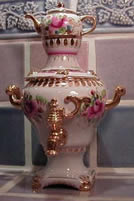
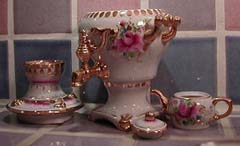
These pictures are of a fairly modern (electric) samovar.
 Older versions had a pipe through the center where coals or wood were actually burned to heat the water.
Older versions had a pipe through the center where coals or wood were actually burned to heat the water.
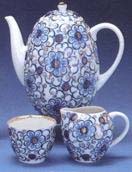 Popularity, traditions and customs of Russian tea drinking, "chaepitie", have helped to foster a uniquely styled system of teapots, teacups, caddies, cozies, and more to support this tradition. By close of the 18th century more than a hundred small factories creating Russian teawares had sprung up. One of the most famous, "Gjel" (Ggel), takes its name from a little cit located in central Russia. Gjel is renowned for their white and blue designs prevalent in today's Russian teawares. Russian teaware designs typically feature images of daily life, most popular being animals and scenes from folk stories.
Popularity, traditions and customs of Russian tea drinking, "chaepitie", have helped to foster a uniquely styled system of teapots, teacups, caddies, cozies, and more to support this tradition. By close of the 18th century more than a hundred small factories creating Russian teawares had sprung up. One of the most famous, "Gjel" (Ggel), takes its name from a little cit located in central Russia. Gjel is renowned for their white and blue designs prevalent in today's Russian teawares. Russian teaware designs typically feature images of daily life, most popular being animals and scenes from folk stories.
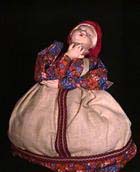
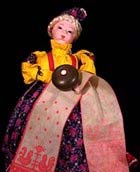 Some examples of these truly Russian teawares are shown here. Tea cozies for samovars are called "baba na samovar" (woman on samovar), and wonderful teaset above that shows the vibrant blue and white pattern that distinguishes Russian tea sets.
Some examples of these truly Russian teawares are shown here. Tea cozies for samovars are called "baba na samovar" (woman on samovar), and wonderful teaset above that shows the vibrant blue and white pattern that distinguishes Russian tea sets.


